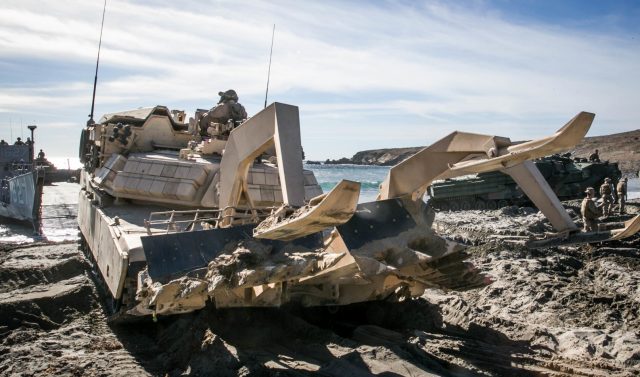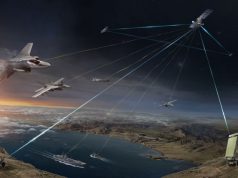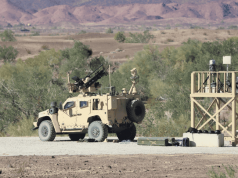
The US Marine Corps is starting work on the development of an unmanned system that could be deployed to clear mine-infested beaches ahead of an amphibious assault.
The prototype – dubbed Crawling Remotely Operated Amphibious Breacher, or CRAB – will be a submersible, remote-autonomous system.
At the front, the vehicle would be equipped with a mine flail, tiller and rake, capable of breaching or proofing amphibious assault lanes for landing forces.
“In theory, the CRAB system will breach through man-made obstacles in the surf zone,” said Capt. Anthony Molnar, Marine Corps Systems Command’s MK154 and MK155 project officer.
The robotic crawlers will splash into the water from a littoral utility craft and travel along the sea floor to remove explosive and nonexplosive obstacles from the assault lane. Each CRAB is intended to be expendable, said Molnar.
“We’ll save lives and reduce costs for the department of Navy and the Marine Corps,” said Molnar.
In the fourth quarter of fiscal year 2019, MCSC submitted a proposal to the Office of Naval Research for the CRAB system as a Rapid Innovation Fund topic for fiscal 2020. Once approved, MCSC is expected to begin a two-year process of developing a prototype.
During this time, they will work with combat development and integration to write the system’s requirements, said Molnar.
The CRAB system will align with the Commandant’s Planning Guidance, a 23-page document that mentions Gen. David Berger’s strategic vision for mine countermeasures. In his guidance, Berger wrote, “We cannot wait to identify solutions to our mine countermeasure needs, and must make this a priority for our future force development efforts.”
Michael Poe, team lead for MCSC’s mobility and counter mobility program, said the technology will be a catalyst in helping marines identify hazards, defeat adversaries and complete missions.
“The CRAB will support combat engineers and explosive ordnance disposal marines by providing a remote or autonomous explosive and nonexplosive obstacle reduction capability within the very shallow water, surf zone and the beach,” said Poe. “It will enable the Marine Corps to provide assured littoral mobility to the Naval Force in support of EABO.”
As Molnar explained, the turbulence of the surf zone makes detecting mines difficult. The Corps currently employs an assault breacher vehicle—an M1A1 tank chassis with a full-width mine plow—and mine clearing line charges for such missions. However, this vehicle is not designed to breach the surf zone.
Treating a dispensable piece of equipment, like the CRAB system, as a mine roller enables marines to safely detonate underwater explosives prior to manned vehicles passing through an amphibious assault lane, said Molnar.
“The CRAB system is important because currently the naval force can only breach in the surf zone with significant risk to mission or personnel,” said Molnar. “This would alleviate that by having an inexpensive and expendable piece of equipment going through there.”


























